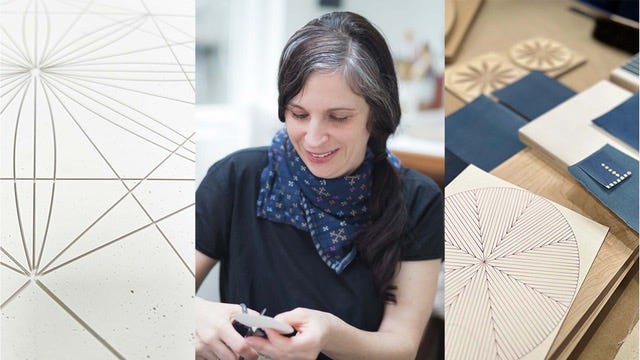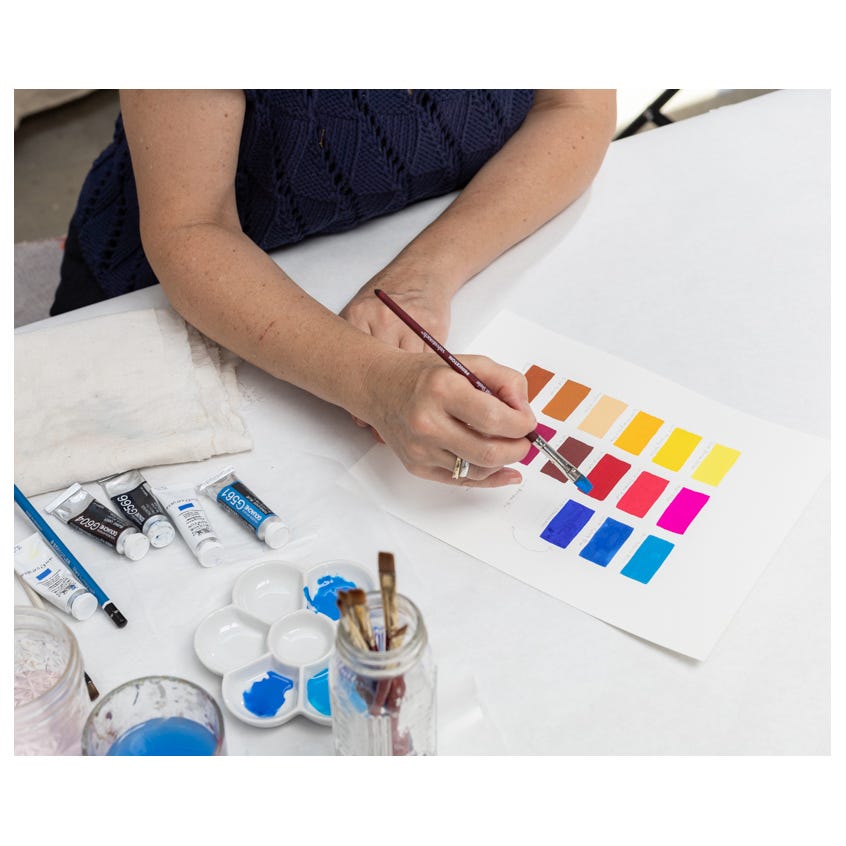Unlocking the Mystery of Color
GUT Color Exploration, Part 1: Hue & Color Charts w/ Visiting Artist Lena Wolff
Hellooo my GUT peeps.
We did it! Our first GUT Gathering was a success. Over 350 people joined from around the world. GUT members finally met “in person” and got to chat a little. We learned some basic watercolor techniques (including my messy approach), and then hung out and drew/painted together. All this without a major technical glitch! It was so much fun, I think we’ll do more in the future. Stay tuned.
If you were unable to attend, never fear. We recorded the gathering for GUT subscribers. The full video is at the end of this newsletter. I’ll put a link to it in the Watercolor 101 newsletter, too.
Let’s get into Color.
The Grown-Ups Table focuses on drawing as a way to experience and connect with the world, each other and ourselves. We also adventure briefly into other mediums (last week, by request, we tried watercolor. Earlier we explored collage. Later this year we’ll do some print making.) But our focus is always on drawing. It’s the foundation of every other art form.
In past GUT dispatches we’ve learned about some of the basic elements of drawing: line, texture, space/composition, value, and perspective.
This week we will begin to explore another element: COLOR. When we think of color, many of us think of paint. But so many drawing-related mediums incorporate color, too: pencils, chalk, pastels, pens.... In the GUT’s color exploration, you are welcome to use any color medium you have/want/are excited by. (Even crayons? Yes, even crayons.) You do you.
Color is a vast and deep subject. It is also not my area of expertise. Luckily, the amazing artist and my friend Lena Wolff has agreed to be a GUT Visiting Artist and do a few color lessons with us. Once a month for the next few months, Lena is going to drop in and give the GUT a color lesson and assignment. We start today.

A quick bit on Lena: Lena Wolff is an interdisciplinary visual artist, craftswoman and activist for democracy who has lived and worked in the San Francisco Bay Area since the early 1990’s. Her work has been exhibited nationally and collected by ONE National Lesbian and Gay Archives, the Berkeley Art Museum, San Francisco Museum of Modern Art, Oakland Museum of California, and more. Her current show is up in Oakland here. . She lives with her wife, artist, teacher and illustrator, Miriam Klein Stahl and their daughter in Berkeley, California. Follow Lena on Instagram.
Lena teaches live color workshops online, so if you dig this lesson, you def want to sign up for her upcoming workshop!
And with that, let’s get this color party started. Lena will take it from here!

Visiting Artist: Lena Wolff on COLOR, Part 1
Hi everyone! I’m Lena. I’m so happy to be here with you at the Grown-Ups Table to talk about color, one of my favorite subjects.
Color is endlessly fascinating, weird, complex and mesmerizing. Even long-time artists and designers who work color for a living can feel both challenged and excited by it at the same time. My goal in teaching color theory is to share simple exercises – a hands-on approach – to build confidence around using color through prompts that are the visual equivalent of what musicians do when practicing chords and scales.
When I teach color I like to start out simple, with the basics, because this is often overlooked (even in art school.) So that’s what we are going to do here at the GUT. We are going to start by getting to know our palettes.
Color, Part 1. Get to know your palette.
What is a palette?
A palette refers to a set of colors, a color theme, or an artist's overall general use of a range of colors. With the exercise we are going to do today, the point is to see all of the colors - or hues - you have on hand, straight out of the tube (or, pen etc) on a single sheet of paper, to use as an ongoing visual reference.
What is hue?
HUE is one of the three essential properties of color (in addition to VALUE and SATURATION, which we’ll talk about later). HUE refers to names of the colors themselves and their relative position on the color wheel, or put in other terms, their location within the visible spectrum of the rainbow. Hues are described as both nouns and adjectives: violet, yellow, blue, red, etc.
Endless variations of hues are possible. Notice the slight differences in hue in the small sampling of relatively similar reds in the paint swatches below:
Why do we have to know what HUE means?
Understanding HUE helps us to organize our colors and name them with a certain amount of accuracy. In Color Theory for Dummies (a book I LOVE!), author and artist Eric Hibbit writes a whole section on steering clear of “fancy language” when studying color (even though it’s fun and poetic), in favor of using standard color terms. As an example, look at some of the names in the color paint chart above, like “Cheese Ravioli.” What color is that??!
In the context of learning about color it’s useful to communicate with a shared vocabulary to describe what we see, to better collectively understand what properties and visual attributes we’re actually talking about.
Why is it important to know your color palette?
Your palette is a starting point to working with color. Getting to know the unique characteristics of the colors you have onhand, in each medium and brand, is the basis of knowing where to begin. Like we saw in the chart above, not all reds are alike! Knowing how the reds in your own palette differ from each other is immensely useful.
In my studio, I have separate color charts for my oil paints, watercolor, gouache, and colored pens. Having these handy, I waste less of my precious materials overall, because I know what each of my colors actually look like before I reach for them for any project!
Which leads us to our first Color assignment/experiment/activity. Today we are going to…
CREATE OUR OWN COLOR CHARTS

So get your colors out and let’s do this together.





